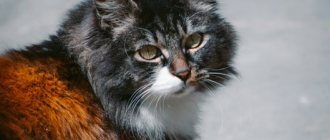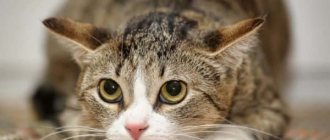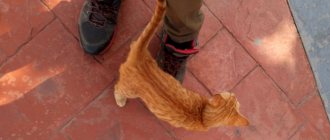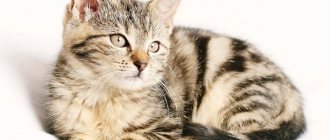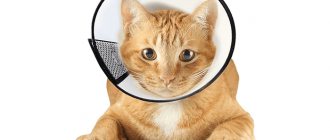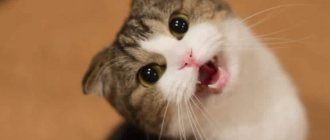The purring of a cat is one of the most pleasant sounds for an animal owner. But the mechanism of origin and its properties still remain a mystery. Even felinologists cannot say exactly when cats learned to purr. It seems that the hoarse vibrating sound relates exclusively to the expression of emotions, but this is not so.
Let's find out what a cat purrs about and how to react to this behavior of a pet.
What is purring and who, besides a cat, makes it?
It is believed that a cat's purring calms both the pet and others. Although objectively this acoustic vibration can also be an alarming signal.
Not only domestic cats purr, but also some inhabitants of the wild world:
- Gorillas, elephants and squirrels can rumble. The desire to express pleasure sometimes appears during food.
- Hyenas, foxes and bears with badgers also periodically grumble and make a sound similar to the purring of a cat.
- A team of predators (from lynx to tiger) is “carried away” by purring singing.
A person hears all this motley “company” only in the zoo from a safe distance, but the sounds of cats at any volume level can be fully enjoyed at home.
If we formulate it without emotional connotation, then purring cats produce a vibrating sound of varying duration in a predominantly low tonal register.
Although there is some gradation in the cat’s vocal roulades, it relates more to the place and circumstances - the cat’s purring changes even depending on the mood of its owner, on whose lap it is located.
This is interesting! Even musicians who can imitate the voice of any animal have not been able to create with their instruments a sound similar to the way cats purr next to a person.
Interesting facts about rumbling
- Cats never meow when communicating with each other; they either purr or hiss;
- If you need your cat to stop purring, just turn on the water. The sound of flowing water will silence the animal.
- Kittens that do not yet have hearing purr while eating, expressing their pleasure;
- A cat's purring during sleep replaces its physical activity;
- Purring before bed helps both the cat and its owner fall asleep, as it drowns out the sounds of breathing and heartbeat.
Rumbling has many emotional connotations. Still, more often than not, pets purr with pleasure. When a cat is fed, caressed and healthy, it will gratefully please its owner with a loud purr.
Mechanism of purring (vocal cords, diaphragm, vascular theory)
One of the options for the formation of unusual sounds that representatives of the cat family make relates to the work of the respiratory organs, muscles in the larynx and vocal cords.
Studies using an electromyograph (a device for studying bioelectrical muscle potentials) have shown the mechanism of a cat's purring to be the use of vocal folds or laryngeal muscles. By rapidly alternating expansion and contraction of the sound passage, they cause rhythmic continuous vibrations of air in the inhalation-exhalation cycle.
It is in this cycle that the characteristic rumbling of a cat is born. The hypothesis does not illustrate all the features of the occurrence of noise, and therefore remains one of the puzzles in a puzzle that has not yet been solved.
Another failed discovery is the launch of the mechanism through the lungs and diaphragm. Observers came to this conclusion when they compared the cat’s purring and its breathing pattern. But they were never able to explain the entire line of behavior, from managing desire to its implementation.
Blood pressure was also not forgotten. They checked how it circulates through the vessels and even suggested the presence of hemodynamic processes - purring is formed as blood moves through the chest. No irrefutable evidence has been found, but at the level of rumors, this hypothesis is being discussed among cat lovers.
The next point of serious research is the hyoid bones and the degree of their hardening. It was noticed that animals cannot both purr and growl at the same time. Therefore, purring cats were enrolled in one group, and roaring cats in the other.
A characteristic feature of the first (including domestic ones) is a completely ossified ligament of the hyoid bones, while in representatives of the second group this property is partially expressed. The exception is the snow leopard. He can purr, like a cat next to a person, but his hyoid bones are not hard.
The most reliable option explaining purring is neurophysiological. A neural network oscillator was discovered in a cat's brain. This phenomenon is complex and even in humans has not been fully studied. Its job is to cause brain waves, which cause the nervous tissue to generate oscillatory activity. These impulses seem to control the hyoid bones, and they, in turn, cause the vocal cords to vibrate.
This is interesting! Cats purr with both their nose and mouth at the same time. At the same time, the body resonates so much that it is impossible to listen to the work of the heart or lungs.
Purring from the point of view of a physiological process
Cat owners, of course, were interested in where exactly such sounds, pleasant to the human ear, come from. There is a feeling that the rumbling is coming from the cat’s soft tummy, but everything is much more complicated.
In fact, the sound comes from the larynx and is formed using the muscles that are located near the vocal cords. This happens during breathing, both during inhalation and exit. But the question arises, how does a cat regulate its funny rumbling, because it breathes even during sleep, but does not make accompanying sounds.
It turns out that muscles begin to participate in the process only when an impulse is supplied from the brain. So, if an animal finds itself in one of the situations described above, the signal is transmitted to the muscles of the larynx. They begin to contract and a person hears a lovely sound when the cat inhales and exhales air.
The unrecognized loudness record holder is Bluey the cat from the UK. According to measurements, the purring reaches 93 dB. Simply put, the sound made by a pet is similar to the noise from a lawn mower. The record is not included in the Guinness Book of Records because the owners did not submit an official application.
The main reasons for a cat's purring
The most common causes of cat purring are:
- The animal purrs when asking for food.
- Demonstrates mood (joy, boredom, gratitude, etc.).
- Cats purr when they want to attract their owner's attention.
- It is believed that even fear stimulates the appearance of a vibrating purr.
- Pain relief and relaxation, for example, a cat may make a purring sound during labor.
Little kittens purr literally from the moment they are born. Sometimes this skill comes to them later, and some do not master the “vocal” art until the end of their days. But the presence or absence of this quality depends on the breed and other individual reasons.
Purring as a stress reliever
Veterinarians say that the process of purring helps a cat cope with pain. Vibration relieves tension from the muscles, from which blood flows to the brain, which helps to quickly calm the pet.
For example, cats purr especially intensely during childbirth. This helps them not only calm down, but also breathe correctly.
If the owner needs to provoke purring, it is recommended to stroke the area of the neck, belly, and back.
Why do cats purr next to a person (when you pet them, they crush them with their claws and lie on their owners)
The gift of healing ailments belongs to the most mysterious section of the cat encyclopedia. The point, apparently, is in the frequency of sounds made and not only in them.
- Cats purr in the range of 20 to 150 hertz (Hz), a very comfortable tonal range that does not cause negative emotional aversion.
- Purring calms and helps to relax - if the cat is comfortable, then the owner has nothing to worry about.
- Often, cats lie on their owners and, when petted, start a quiet, monotonous “song.” Felinologists believe that the vibration of their body and the low sound of purring (20-50 Hz) have a beneficial effect on the condition of bones and joints. And higher tones can heal skin and muscle tissue.
- It has been noticed that animals “feel” injured areas on the human body - the cat purrs, lies down on the sore spot, and after a while the owner feels better.
Most likely, cats purr and lie on their owners, thanks to the natural instinct to settle in the warmest place. Inflamed areas of the body have an increased temperature, so the pet chooses them instinctively.
Even traditional stomping (with or without claws) can be considered a massage, but scientists attribute this ability to a genetic memory of preparing a den for sleep.
Why do we love it when cats purr?
A cat's purring evokes pleasant emotions in many people. Scientists have found that there are certain reasons for this. Research has shown:
- the range of sounds made by a cat has a beneficial effect on bone tissue;
- uniform rumbling improves the functions of the nervous system;
- the vibration that occurs when purring normalizes blood supply to the brain, blood pressure, and heart rate;
- the state of peace that appears with these sounds relieves stress and prevents depression.
Our body, on a subconscious level, strives to obtain the positive effect that “cat songs” provide, telling about calm, safety, relaxation and enjoying comfort.
How to determine by purring what a cat wants
The meaning of a cat's purring depends on the animal's mood and health.
- He rubs against his legs, purrs and arches his back - he greets and attracts attention.
- It rumbles as soon as the owner is in the kitchen, next to food - he wants to eat.
- She settled down next to the owner somewhere on the sofa, purred, demanding affection.
- It bends over, stomps in one place and purrs endlessly - probably the animal is in pain.
- The unreasonable purring of a cat that is resting means that it has found a comfortable place for itself.
Rumbling in communication with a person
Cat owners most often perceive purring as a sign of gratitude, but cats express a whole range of emotions with this sound. Let's figure out why cats purr.
- Cats are very sensitive to the emotional state of the owner. If the owner is tired, upset or depressed, the small pet will always try to lie down next to him or in his arms and begin to purr. It has been scientifically proven that the frequency of purring puts a person into a trance, akin to meditative practices, and he calms down.
- Often, purring is an expression of pleasure. When you pet your pet to show your love, your cat will begin to purr to show how much she likes it.
- Domestic cats are talented manipulators. When begging for a treat or affection, they may poke their heads into your hand, making a purring noise. Or rub against your legs.
- If, lying next to the owner, the cat stops purring and listens, it means that something has alerted the animal.
If your cat is constantly purring, you should pay attention to your pet's health. The animal may be sick or injured. The pet could have problems with the vocal cords, and the cat is simply not able to meow.
Owners who wonder why a cat purrs like a tractor may simply not notice that not everything is all right with the animal, and in this way it heals and calms itself.
An attentive owner will always notice oddities in the pet’s behavior.
What to do if your cat doesn't purr
Arbitrary options for the appearance or absence of “musical” abilities in cats are possible:
- Volume. Some cats purr in a barely audible voice.
- Genetics. The English Devon Rex does not purr itself, and does not teach its children to do so.
- Mood. A purring cat can remain silent for a long time. The reasons are different - from resentment towards the owner to jealousy towards others.
Vibration and sound, typically signifying the purring of a cat, is an optional sign of mood, breed or attitude towards a person.
The therapeutic effect of purring
Experienced owners say that cats sense illness, and if the pet always sits on its stomach or chest, you should consult a doctor.
Psychologists distinguish such a concept as feline therapy - a method of treating or preventing various diseases through contact with a cat. Its effectiveness has been confirmed by numerous experiments.
Thus, American scientists have found that when a cat purrs, a person’s blood pressure and pulse normalize. And Russian zoologists have found that cat owners, according to statistics, live several years longer and suffer 20% less from problems with the cardiovascular system.
Today, feline therapy is especially popular for the treatment of diseases such as depression, anxiety, irritability and stress, and migraines.
The most purring breeds
Until now, no pattern has been identified that explains the desire of cats to purr. Owners are inclined to the theory of sociability - the more sociable the animal, the more talkative it is. This means that the cat that purrs is one that wants to spend time with its owner. Pedigree and street cats have equal chances here.
As for the volume level, its maximum is 20 decibels, which is quite comfortable for human hearing. For comparison, street noise is 2.5 times louder.
This is interesting! The mongrel cat Smokey from England became famous for her outstanding purring - she purred 68 dB, was included in the Guinness Directory, and at the same time forced her owner to move away from her neighbors.
Purring phenomenon
Throughout the history of mankind, the cat has accompanied us. Tens of thousands of years ago, the inhabitants of the Middle East tamed the wild steppe cat, and since then it has become a symbol of the hearth and home.
Due to its special unusual sound, in ancient times this animal was a symbol of fun and play, but in the Middle Ages the mysterious essence of purring began to be considered devilish and sinful.
Modern cat lovers know that their songs are not sent from heaven or hell, but are the result of a physiological process. It is not entirely clear which organ is responsible for sound; only one thing is clear – sounds are produced consciously and controlled by the animal itself.
Physicists have discovered that a cat's body emits electromagnetic impulses that produce loud or quiet sounds. They are beneficial for animals and humans, have a healing effect and bring peace and tranquility to the atmosphere of the home.
Do big cats purr?
When it comes to pets, they all purr. The Maine Coon, Ashera and the Siberian cat, which is familiar to Russia, make sounds characteristic of all representatives of the cat family.
But with wild big cats everything is different. Cheetahs purr accurately and often become objects of scientific research. In India, they traditionally live in yards and perform the duties of house cats. Tigers, according to scientists, should not rumble. But let’s remember the painting “Striped Flight”, the legendary Margarita Nazarova and her pet nicknamed Pursh. If he wasn’t purring for his trainer on the deck of the ship, he was definitely purring very gently.
The true reasons for a cat's purring still have no scientific basis. But an attentive owner notices even minor changes in the sound of his pet's voice. Therefore, he will be able to understand the reasons for this behavior and will definitely protect his cat from possible danger.
Scientists' opinion
Zoologists believe that the occurrence of purring is primarily associated with motherhood. With this sound, the mother calms the babies, lets them know that she is nearby, and can also warn of danger.
In addition, researchers from the American Stanford Institute found that purring helps strengthen bones.
A pet's sedentary lifestyle, which spends most of the day sleeping, does not affect the health of the musculoskeletal system precisely because of this ability: vibration restores musculoskeletal activity.
Are all cat breeds equally talkative?
Zoologists claim that there are breeds that are hereditarily conditioned to be more “talkative,” and there are others that are the opposite. For example, Cornish Rex, Siamese, and Thai are considered very talkative. Devon Rex and Ragdoll are less talkative. These factors need to be considered before taking a pet into your home.
Regardless, you should enjoy the time you spend with your pet. It’s so nice to pet a purring kitten after an active day. After all, in this way they give us their love and affection.
